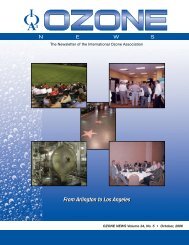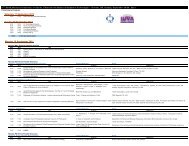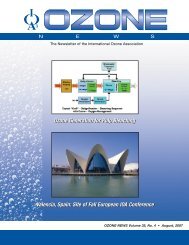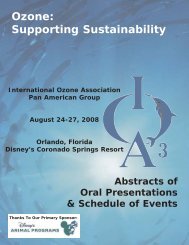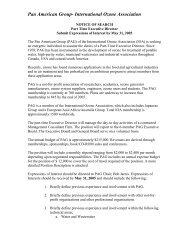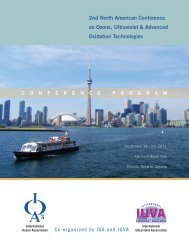Vol 33 No 4 Text - International Ozone Association
Vol 33 No 4 Text - International Ozone Association
Vol 33 No 4 Text - International Ozone Association
You also want an ePaper? Increase the reach of your titles
YUMPU automatically turns print PDFs into web optimized ePapers that Google loves.
<strong>Ozone</strong> News <strong>Vol</strong>ume <strong>33</strong>, <strong>No</strong>. 4<br />
Table I. Treated water quality in each treatment process<br />
suspended matters but also ova or larva of organisms.<br />
As a result, the final treatment water can provide a<br />
better water quality than that of Japanese reuse<br />
standards. The outbreak of Chironomid in<br />
reclamation water could be also eliminated.<br />
Treatment efficacy of Cryptosporidium oocysts<br />
The determinations of Cryptosporidium oocysts were<br />
carried three times for the duration of continuous test.<br />
The results are shown in Table II. The determinations<br />
could not prove whether Cryptosporidium oocysts<br />
detected in ozone treatment water were active or<br />
inactive. But it was reported in other research<br />
(Oomura etc,2000) that Cryptosporidium oocysts was<br />
inactivated to approximately 4 log by ozone, as shown<br />
in Table III. Therefore, it is considered that<br />
Cryptosporidium oocysts are inactivated by this ozone<br />
system with C.T. value of more than 13 (mg/L?min.).<br />
Moreover, Cryptosporidium oocysts in MF<br />
membrane treatment water are not detected at all.<br />
This reveals that ozone and MF membrane provide<br />
double hygienic barrier against pathogenic organisms.<br />
Page 23<br />
Table II.Removal effect of Cryptosporidium oocysts<br />
Table III. Inactive ratio of C.P.O. to CT value by <strong>Ozone</strong>




